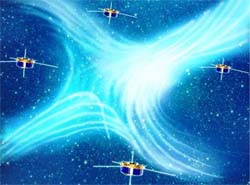
A schematic diagram of the spiral structure of the magnetic field around the null.

An international team led by Chinese scientists has found the first
in situ evidence for the existance of a null point in the central area of megantic reconnection. The discovery was reported in the July issue of
Nature Physics.
Magnetic reconnection, a process whereby the lines of a complex magnetic field break and reconnect to alter its structure drastically, is of fundemental importance to the studies of astrophysical, space and laboratory plasmas, says XIAO Chijie, lead author of the
Nature Physics article and an astrophysicst from the National Astronomical Obervatories at CAS (NAOC).
For instance, solar flares, the largest explosions in the solar system, are caused by reconnection of large systems of magnetic flux on the Sun, releasing in minutes energy that is stored in the magnetic field over a period of weeks to years, which is sometimes billion times more powerful than an atomic bomb. Magnetic reconnection in Earth's magnetosphere is responsible for the aurora, and it is important to the science of controlled nuclear fusion, which provides scientific basis for the so-called "man-made sun," because it is one mechanism preventing magnetic confinement of the fusion fuel.
Identifying the structure around the point at which the magnetic field lines break and subsequently reconnect, known as the magnetic null point, is crucial to improving our understanding of the reconnection. But owing to the inherently three-dimensional nature of this process, magnetic nulls are only detectable through measurements obtained simultaneously from at least four points in space. Until recently, there was no direct observation evidence for their existance.
Using data collected by the four spacecraft of the Cluster constellation and Double Star Program (DSP) and the method of Differential Topology developed by ZHAO Hui, a Ph. D student at NAOC, Xiao and his co-workers reported the first in situ evidence for the structure of an isolated magnetic null. The results indicate that it has a positive-spiral structure whose spatial extent is of the same order as the local ion inertial length scale, suggesting that the Hall effect could play an important role in 3D reconnection dynamics.
At the proposal of CAS scientists, the two DSP satellies join hands with four Cluster ones to carry out the unprecedented six-point simultaneous observation network in space. It also provides the state-of-the-art approach for space exploration in terms of terrestrial space environment, and three-dimensional characteristics of geomagnetic field. Magnetic reconnection is one of the major issues of the DSP-Cluster mission.
The find is applauded by the world S&T community. It is of very importance for us to understand the activities of astrophysical and space plasma, and will be helpful for solving some of the long-standing puzzles concerning magnetic reconnection, says John M. Finn, a famous astrophysicst from the Los Alamos National Laboratory in USA. in an article of the same issue of
Nature Physics.
This scientific breakthrough is a truly experimental "tour de force," exclaims an article at the web site of the European Space Agency (ESA). "For the first time, the heart of the magnetic reconnection process is revealed. The properties derived are fundamental to understand the dynamics of 3D reconnection around magnetic nulls. This result is a major achievement of the Cluster mission," says Philippe Escoubet, DSP-Cluster roject scientist of ESA.








